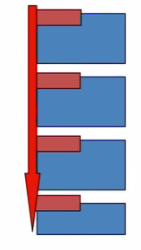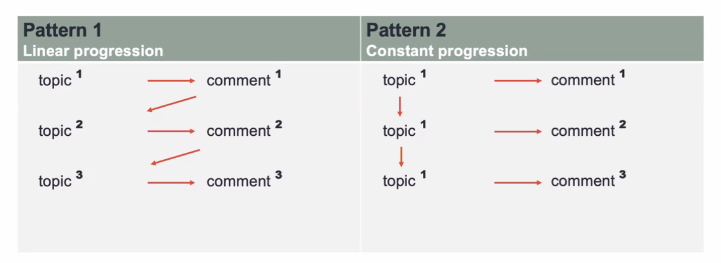Some notes from the writing course I’m taking.
Lecture 1, 14 November
Resources
Searching phrases/alternatives in quotes in Google Scholar can tell which one is more frequently used.
https://ozdic.com contains collocations: words frequently occuring together with the searched word.
https://www.english-corpora.org/iweb another resource for looking collocations; more scientifically rigorous than Ozdic.
https://books.google.com/ngrams counts ngram usage over time, and compares usage over time. Also allows e.g.
* difference*to find the most common word beforedifference.https://scholar.google.com: Allows search quoted terms for frequency count in papers.
Cambridge and Oxford dictionaries are good enough. They not only give definitions but also typical usage and e.g. common proposition.
Reader friendlyness
- Keep subject and verb close to each other.
- Avoid unneeded words; keep things brief.
- Avoid multiple reasons (
in order to,owing to,due to). Even avoidIn order tocompletely; justTosuffices. - Avoid complicated words; no unneeded repetitions.
Typical problems
- Object far from verb
- Front-loading
- Dangling modifiers
- Lack of parallelism
- Redundancy: A, which B, that C, so that D.
- Stacking
- Turgid sentences: overstuffed.
Lecture 2, 21 November
Paragraph level expectations

- Topic sentence: 1st sentence of paragraph creates expectations about the content of the rest of
the paragraph.
- don’t have to, but recommended
- makes implicit expectations explicit
- should not be too specific. Following sentence make things more precise.
- simple, wide, not specific, not too vague
- Preview sentence / Framing sentence
- establish expectations about the structure of the paragraph
- Can give the number of items following: We distinguish two cases.
- Topic and preview sentence may be merged.
- Possible paragraph structure
- Topic sentence
- Preview sentence
- Aspect 1
- Detail 1
- Aspect 2
- Detail 2
- Conclusion (optional)
- Other paragaph structures:
- general -> specific
- specific -> general
- situaion - problem - solution - evaluation
- compare - contrast
- advantages - disadvantages
- cause - effect
- chronological
Flow
Beginning of sentence follows up on very end of previous sentence.
Default flow: old to new.
- Begin with old information (possibly repetition)
- Move on to new information.
- Repetition because of this is OK, and can help reader understanding.
Sometimes this is not possible, or we have a focus shift, use a linker / transition marker, e.g. however.
Starting with new information can be used for special effect, but should be used sparingly.
Flow strategies:
- Exact/partial repetition: variation of a word; synonyms; pronouns (it, they, these, …).
- This/These + summary noun, e.g. these ideas.
- Fronting: place a phrase/clause at the start of the sentence, e.g. In England, it rains a lot.
- Passive voice to move new information to the end.
But: sometimes beginning of sentence refers to beginning of previous sentence.
- e.g. multiple comments about the same thing.
Conclusion: multiple possible information progressions.

argumentation: linear progression
description: constant progression
For technical terms, exact repetition (or possibly partial repetition) is preferred over synonyms that may end up being confusing.
Assignment for next week
2 paragraphs of texts for a paper/thesis/…., by monday.
Lecture 3, 28 November
- Repeating things is a good thing. Helps reader.
- Don’t be afraid to repeat e.g. procedure a few times. Synonyms are not
Bad organization
chronological
Bundling all proofs/results in one section and discussion elsewhere
rambling introduction on tangentially related research
Unfounded claims of relevance
Disproportionate attention to minor details
Not sufficient context
No motivation
No signposting

Figures
- Introduce fig: Figure X shows …
- Describe: As can be seen, …
- Highlight key points: The most common …
- Commenting on the results:
Commenting from strong to weak:
- shows
- suggests
- indicates
- implies (in an informal sense, rather than mathematical sense)
Modal verbs and adverbs:
canstronger thancouldmaystronger thanmight*would* seemsprobably
Don’t be too weak! You do want to explain the properties of the data.
Figure 5 shows X: indicative, what is shownFigure 5 shows *that* X: informative, conclusion drawn from what is shown.is shown in table 1: 1.8MTable 1 shows: 3.3M(see table 1): 4MAs shown in Table 1: 1.6M
References to figures
- We report .. in table 1
- Table 2 shows …
- In Table 3a we report …
- Table 3a is presented to highlight …
- Figure 1 shows an example of …
- Figure 2 shows the average number of …
- This is graphically evident from Figure 2, looking at …
- Figure 3 shows an example.
- At the other end of .. visible in Figure 4,
- In Figure 4 we show
- As already noted in Figure 4
- as shown in step 3 of the pseudocode
Conclusions:
- All indicative, none informative
- No imperative
- No parens
- All present tense
- Verbs:
shows - Examples:
in ... we report
Indicative vs Informative (ex. 7)
- indicative: Table 1 shows X
- informative: Table 1 shows that X
| indicative | informative | |
|---|---|---|
| show | y | y |
| illustrate | y | y |
| reveal | n | y |
| indicate | n | y |
| demonstrate | y | y |
| suggest | n | y |
| give | y | y |
| present | y | n |
| display | y | y |
| summarise | y | n |
| provide | y | n |
Lecture 4, December 5
Introduction
Functions in introduction
- Problem
- Solution
- Research context
- Results
- Benefits
- (Limitations)
Moves:
Establish research territory
- Show that the area is important/problematic/relevant in some way (almost always)
- Review related work.
‘claiming centrality’; emphasize importance
- present perfect:
has been studied, started in the past and still now - present simple:
remains
both talk about the importance of the work in the present
Establish a niche
- something is missing
- something needs to be added
- something isn’t good enough
- ‘mini-critique’
- indicate contrast
Examples:
- Little work has been done
- Few studies have …
- less attention
- studies have emphasized A as opposed to B
Occupy the niche
- outline the structure of text
- outline purpose
- listing research questions
- principal findings
- indicating value
Introduction phrases: https://www.phrasebank.manchester.ac.uk/introducing-work/
- Move 3 takes most of the space. Move 2 takes very little space.
Conclusion
- looking back
- looking forward
Example structure, specific to general:
- restatement of aims
- summary of methods/results
- comparison to other research
- limitations
- implications/impact
- recommendations/future research
Tense
we solved,we presented(past simple), is in the past but somewhat detached from the now.we have solved(present perfect) makes it more relevant for now. (Either works.)- Don’t use use present tense (
we conduct). More research will be needed ...
Lecture 5, December 12
Abstracts
Possible structures:
- AMRC
- (Background)
- activity/purpose
- methods
- results
- conclusion
- B/SPSE
- Background/situation
- problem
- solution
- evaluation
Titles
- Most often a long noun phrase.
- Sometimes two parts.
- Rarely a question.
Punctuation
Comma
Do use comma:
- Before and, or, but, yet, for, and so when connecting two main
complete clauses.
- Not: A does not rely on X but on Y.
- Around non-defining relative clauses (i.e. when it can be removed without
losing meaning):
- The teacher, who is called Mark, is cool.
- My girlfriend, who lives in spain, … (My only one, who happens to live there.)
- Oxford comma
- When subordinate clause with (although, because, when, if, unless,
until, since, before) precedes main clause:
- When you do X, you may do Y.
- After introductory phrase:
- Additionally, …
- Before submission, …
- Around inserted phrase/interruption:
- A, or sometimes B, is special.
Do not use comma:
- Between incomplete clauses:
- I wrote a book and read it.
- Between defining relative clause:
- Clauses that are not connected …
- My girlfriend who lives in Spain, … (The one in spain, not the other one.)
- When the main clause precedes the subordinate clause:
- We eat until we are all finished.
- Not before that … if the subclause is the object/subject.
- We believe that …
Dashes
- hyphen: to join inseperable words.
- n-dash: for ranged and periods of time. calais-dover, 1999-2019.
- m-dash: to separate and insert whole phrases. No spaces around it in British English.